封闭过程中火区气体运移规律的数值模拟
2015-03-08周西华李诚玉张丽丽宋东平门金龙
周西华,李诚玉,张丽丽,宋东平,门金龙
(1.辽宁工程技术大学安全科学与
工程学院,辽宁阜新 123000;2.矿山热动力灾害与防治教育部重点实验室,辽宁阜新 123000;3.新疆工程学院,新疆乌鲁木齐 830091)
0 引言
矿井火灾发生以后,直接灭火没有显著效果的情况下,应立即着手实施封闭火区的工作[1-5]。及时封闭火区能起到安全有效地控制和熄灭火灾,减少火灾造成的生命、财产的损失作用。封闭过程中火区内爆炸性气体形成积聚和引爆是安全方面的最大威胁。目前,蒋大成等学者对煤的自燃过程及煤的对流换热进行了研究[5-9],李宗翔等学者对瓦斯聚集规律进行了研究[10-12],周西华等学者对采空区及封闭火区的瓦斯运移规律进行了研究及数值模拟[13-15],但均未对封闭过程中生成气体的运移、积聚规律以及瓦斯爆炸危险性进行研究。为此,有必要对封闭过程中火区气体运移规律进行研究。本文主要对封闭过程中火区瓦斯、CO和O2三种气体的运移规律进行研究,通过数值模拟来展示封闭过程中各种气体的生成、运移及浓度分布,从而判断火区瓦斯爆炸危险性。
1 逆流层的形成机理及条件判别式
在巷道火灾中,如果当风速较小且燃烧强度较大,则风流会与高温燃烧产物分层流动,在顶板附近高温烟流流动方向与新鲜风流方向相反,即烟流逆退,称为烟流逆流层现象[16]。火区封闭过程中,风流速度减小,燃烧生成气体会形成逆流层。
逆流层形成的巷道烟流最高温度条件的判别式[17]:

根据文献,巷道平均风速条件的判别式[17]:

式中:ν——巷道平均风速;
Tn——断面上烟流温度/℃;
T0——断面上风流温度/℃;
φn——混合比;
μ0——燃烧生成气体脱离可燃物表面的速度/(m/s);
g——重力加速度/(m/s2);
hm——巷道高度/m;
μ——巷道摩擦系数;
f——实验常数,取值范围:0.004 ~0.0046;
f3——转换系数,表示烟流最大垂直速度与水平逆流速度之比。
2 火区封闭过程数学模型的建立
2.1 模型建立及网格划分
计算用模型尺寸设计为宽4 m,高3 m,长50 m的矩形水平巷道,巷道顶、底板及两帮均设为0.5 m厚岩石。火源为煤堆,煤堆中心距离入口16 m,煤堆底面直径1 m,高0.2 m,顶面直径0.5 m。模型如图1。

图1 计算模型Fig.1 Calculation model
对模型采用自由四面体网格剖分,并在煤堆表面用自由三角形单独加密,整个模型共划分434533个网格(图2、图3)。

图2 网格划分Fig.2 Mesh generation

图3 局部网格加密Fig.3 Local grid refinement
2.2 边界条件及初始条件
火区存在三个物理场:流场、传热场、传质场,流场采用湍流模型,从左面流入右面流出,在受热后由于体积力作用存在强制对流,入口法向初始速度为2 m/s,出口为压力边界;传热采用固-气耦合传热,煤堆为热源,假设在整个燃烧过程中可燃物充足,由于煤质不同,生成热量不同,本文放热量采用“氧耗法”进行估算,即单位质量氧气消耗所产生的能量是13.1 mJ/kg,煤堆及巷道顶底板、两帮为固体传热,由于外部为地层岩石,所以外部边界设为对流冷却,风流为流体传热,初始温度为293.15K(20℃);传质采用对流扩散模型,风流入口各气体浓度为定值,煤堆表面发生煤的燃烧反应,巷道壁有瓦斯涌出,入口初始值为:O2浓度21%,CH4浓度0.1%,CO2浓度0.03%,CO浓度为零,火灾初期为富氧燃烧,煤堆表面燃烧反应耗氧量按照氧气浓度不低于15%计算,生成气体为CH4、CO2、CO,火源温度达到1300℃前生成气体比例为0.05:1:1,火源温度达到1300℃后生成气体比例为0.05:1:2,巷道壁面瓦斯涌出量为0.048 m3/s。封闭过程中入口风速逐渐减小,流场必然发生变化。忽略封闭初期供风量的减少对燃烧生成热量及生成气体的影响,假设供风量呈线性下降,在60 min内完成封闭,封闭后存在少量漏风(1.2 m3/s),则入口速度边界改为时间的分段函数即

3 火区封闭过程中流场变化的数值模拟
利用COMSOL进行数值模拟,得到入口风速分别为 1.5 m/s、1 m/s、0.5 m/s、0.25 m/s、0.1 m/s时巷道中心断面的流场分布图,(图4~图8),巷道中心垂直断面最大风速变化趋势见图9,逆流层厚度变化趋势见图10,逆流长度变化趋势见图11,最大逆流速度变化趋势见图12。

图4 入口风速1.5 m/s时风速分布图Fig.4 Distribution map of wind speed as entrance wind speed is 1.5 m/s

图5 入口风速1 m/s时风速分布图Fig.5 Distribution map of wind speed as entrance wind speed is 1 m/s

图6 入口风速0.5 m/s时风速分布图Fig.6 Distribution map of wind speed as entrance wind speed is 0.5 m/s

图7 入口风速0.25 m/s时风速分布图Fig.7 Distribution map of wind speed as entrance wind speed is 0.25 m/s

图8 入口风速0.1 m/s时风速分布图Fig.8 Distribution map of wind speed as entrance wind speed is 0.1 m/s
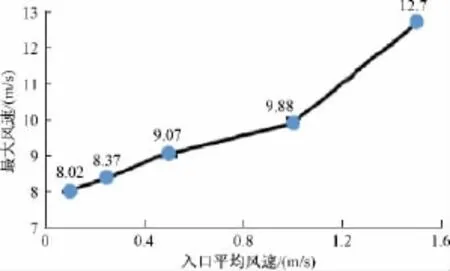
图9 巷道中心垂直断面最大风速Fig.9 The highest wind velocity of center vertical section of tunnel
由图4~图12可看出,封闭过程中随着入口平均风速的减小,巷道中心垂直断面最大风速逐渐减小,当入口平均风速降为0.1 m/s时,巷道中心垂直断面最大风速为8.02 m/s,根据流线及流速矢量箭头可看出,在入口平均风速降到1.5 m/s以下时将形成逆流层,逆流层厚度、逆流长度和最大逆流速度均随着入口平均风速的减小而增大,当入口平均风速降为0.1 m/s时,逆流层厚度为1.45 m,逆流长度为10.1 m,最大逆流速度为4.4 m/s。
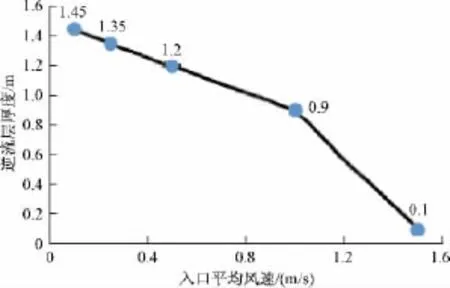
图10 逆流层厚度Fig.10 Thickness of smoke back-flow layer
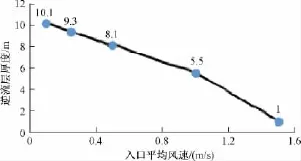
图11 逆流长度Fig.11 Length of countercurrent flow
4 火区封闭过程中瓦斯爆炸危险性
火区封闭过程中供风量减小,但巷道瓦斯涌出量几乎不变,必然导致瓦斯浓度升高[9-11]。火区封闭过程中巷道中心垂直断面瓦斯浓度分布见图13~图17,巷道中心垂直断面最高瓦斯浓度变化趋势如图18,火源下风侧最高瓦斯浓度变化趋势如图19。

图14 入口风速为1 m/s时瓦斯浓度分布图Fig.14 Distribution map of CH4concentration as entrance wind speed is 1 m/s

图15 入口风速为0.5 m/s时瓦斯浓度分布图Fig.15 Distribution map of CH4concentration as entrance wind speed is 0.5 m/s

图16 入口风速为0.25 m/s时瓦斯浓度分布图Fig.16 Distribution map of CH4concentration as entrance wind speed is 0.25 m/s

图17 入口风速为0.1 m/s时瓦斯浓度分布图Fig.17 Distribution map of CH4concentration as entrance wind speed is 0.1 m/s
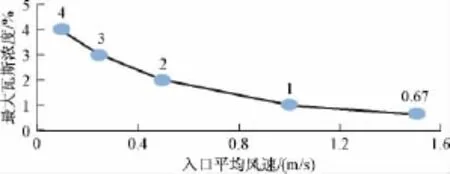
图18 巷道中心垂直断面最高瓦斯浓度Fig.18 The highest CH4concentration of center vertical section of tunnel

图19 火源下风侧最高瓦斯浓度Fig.19 The highest CH4concentration below fire source
火区封闭过程中巷道中心垂直断面一氧化碳浓度分布见图20~图24,火源下风侧巷道中心垂直断面一氧化碳平均浓度变化趋势如图25,火源上风侧一氧化碳最高浓度变化趋势如图26。

图20 入口风速为1.5 m/s时一氧化碳浓度分布图Fig.20 Distribution map of CO concentration as entrance wind speed is 1.5 m/s

图21 入口风速1 m/s时一氧化碳浓度分布图Fig.21 Distribution map of CO concentration as entrance wind speed is 1 m/s

图22 入口风速0.5 m/s时一氧化碳浓度分布图Fig.22 Distribution map of CO concentration as entrance wind speed is 0.5 m/s

图23 入口风速0.25 m/s时一氧化碳浓度分布图Fig.23 Distribution map of CO concentration as entrance wind speed is 0.25 m/s

图24 入口风速为0.1 m/s时一氧化碳浓度分布图Fig.24 Distribution map of CO concentration as entrance wind speed is 0.1 m/s
火区封闭过程中巷道中心垂直断面氧气浓度分布见图27~图31,火源下风侧巷道中心垂直断面氧气平均浓度变化趋势如图32。
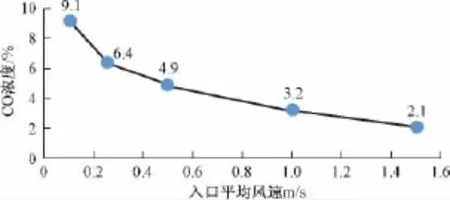
图25 火源下风侧巷道中心垂直断面一氧化碳浓度Fig.25 CO average concentration of center vertical section of tunnel below fire source
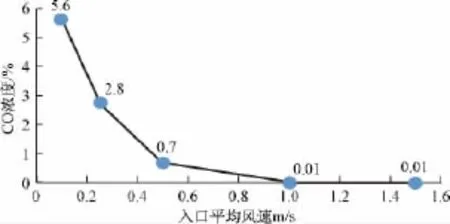
图26 火源上风侧一氧化碳最高浓度变化趋势Fig.26 CO average concentration of center vertical section of tunnel on the weather side of fire source

图27 入口风速为1.5 m/s时氧气浓度分布图Fig.27 Distribution map of O2concentration as entrance wind speed is 1.5 m/s

图28 入口风速为1 m/s时氧气浓度分布图Fig.28 Distribution map of O2concentration as entrance wind speed is 1 m/s

图29 入口风速为0.5 m/s时氧气浓度分布图Fig.29 Distribution map of O2concentration as entrance wind speed is 0.5 m/s

图30 入口风速为0.25 m/s时氧气浓度分布图Fig.30 Distribution map of O2 concentration as entrance wind speed is 0.25 m/s

图31 入口风速为0.1 m/s时氧气浓度分布图Fig.31 Distribution map of O2concentration as entrance wind speed is 0.1 m/s
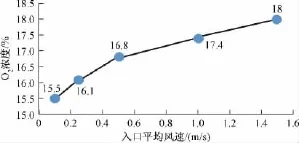
图32 火源下风侧巷道中心垂直断面氧气平均浓度Fig.32 O2average concentration of center vertical section of tunnel below fire source
由图13~图32可看出,火区封闭过程中火区最高瓦斯浓度及火源下风侧最高瓦斯浓度均随着入口平均风速的减小而增大,在入口平均风速为1.5 m/s时巷道中心垂直断面最高瓦斯浓度较小,出现在火源下风侧,火源下风侧巷道中心垂直断面一氧化碳平均浓度为2.1%,火源上风侧一氧化碳浓度几乎为零,火源下风侧氧气平均浓度为17%,当入口平均风速继续减小时随着逆流层的发展,巷道中心垂直断面最高瓦斯浓度出现在逆流层边缘位置,火源下风侧巷道中心垂直断面一氧化碳平均浓度不断升高,火源上风侧出现一氧化碳且浓度不断升高,火源下风侧氧气不断降低,当入口平均风速降为0.1 m/s时,巷道中心垂直断面最高瓦斯浓度为4%,火源下风侧最高瓦斯浓度为2%,火源下风侧巷道中心垂直断面一氧化碳平均浓度为9.1%,火源上风侧一氧化碳最高浓度为5.6%,火源下风侧氧气平均浓度为12.1%。根据火区瓦斯爆炸危险性实验[18],火源上风侧10.1 m处混入一氧化碳浓度大于5%,火区温度高于100℃,瓦斯爆炸下限降到2.8%以下,而该区域瓦斯浓度为4%且氧气浓度相对较高,极有可能发生瓦斯爆炸。
5 结论
(1)分析了火区封闭过程中逆流层的形成机理,巷道平均风速和逆流层形成的巷道烟流最高温度条件的判别式。
(2)根据模拟结果可看出,在入口平均风速降到1.5 m/s以下时将形成逆流层,逆流层厚度、逆流长度和最大逆流速度均随着入口平均风速的减小而增大。
(3)火区瓦斯及一氧化碳浓度随着风速减小而增大,当风速降低到0.1 m/s时,火源上风侧10.1 m处巷道顶板附近,混入一氧化碳浓度大于5%,火区温度高于100℃,瓦斯爆炸下限降到2.8%以下,而该区域瓦斯浓度为4%且氧气浓度相对较高,极有可能发生瓦斯爆炸。
[1]周心权.矿井火灾防治[M].徐州:中国矿业大学版社,2002:146-160.ZHOU Xinquan.Mine fire controlling[M].Xuzhou:Chinese University of Mining and Technology Press,2002:146-160.
[2]俞启香.矿井瓦斯防治[M].徐州:中国矿业大学出版社,1992:40-52.YU Qixiang.Mine gas controlling[M].Xuzhou:Chinese University of Mining and Technology Press,1992:40-52.
[3]梁运涛,罗海珠.中国煤矿火灾防治技术现状与趋势[J].煤炭学报,2008,33(2):126-130.LIANG Yuntao,LUO Haizhu.Current situation and development trend for coal mine fire prevention and extinguishing techniques in China[J].Journal of China Coal Society,2008,33(2):126-130.
[4]焦宇,周心权,康与涛.矿井平巷木材火灾烟流滚退理论分析与实验研究[J].煤炭学报,2010,35(12):2105-2110.JIAO Yu,ZHOU Xinquan,KANG Yutao.Theoretical analysis and experimental study on backflow smoke of mine laneway wood fire[J].Journal of China Coal Society,2010,35(12):2105-2110.
[5]于水军,余明高,谢锋承,等.无机发泡胶凝材料防治采空区托顶煤自燃火灾[J].中国矿业大学学报,2010,39(2):173-177.YU Shuijun,YU Minggao,XIE Fengcheng,et al.An inorganic foaminggel for preventing spontaneous combustion in a top-coal falling region[J].Journal of China University of Mining &Technology,2010,39(2):173-177.
[6]胡社荣,蒋大成.煤层自燃灾害研究现状与防治对策[J].中国地质灾害与防治学报,2000,11(4):72-75.HU Sherong,JIANG Dacheng. Thedisasterof spontaneous combustion of coalbeds and countermeasure of prevention [J]. The Chinese Journal of Geological Hazard and Control,2000,11(4):72-75.
[7]李绪萍,邓存宝.高温壁面与煤内自然对流传热分析[J].中国地质灾害与防治学报,2013,24(4):127-131.LI Xuping,Deng Cunbao.High temperature wall and natural convection heat transfer in coal[J].The Chinese Journal of Geological Hazard and Control,2013,24(4):127-131.
[8]邢永强,冯进城,荣晓伟.河南平煤四矿煤矸石山自燃爆炸成因及防治分析[J].中国地质灾害与防治学报,2007(2):145-150.XING Yongqiang,FENG Jincheng,RONG Xiaowei.Discussion on causes of combustion and explosion and of coal gangue at the No.4 mine of Pingdingshan Coal Mine and countermeasures[J].The Chinese Journal of Geological Hazardand Control,2007,18(2):145-150.
[9]周西华,王继仁,梁栋,等.山东兖州东滩矿3#煤层自燃临界氧浓度指标研究[J].中国地质灾害与防治学报,2006,17(4):129-133.ZHOU Xihua,WANG Jiren,LIANG Dong,et al.Critical oxygen concentration indictor of coal spontaneous combustion at the 3rd coal seam of Dongtan Mine,Yanzhou,Shandong Province[J].The Chinese Journal of Geological Hazard and Control,2006,17(4):129-133.
[10]李宗翔,题正义,赵国忱.回采工作面采空区瓦斯涌出规律的数值模拟研究[J].中国地质灾害与防治学报,2005,16(4):46-50.LI Zongxiang, TI Zhengyi, ZHAO Guochen.Numerical simulation of gas emission in goaf of robbing working surface[J]. The Chinese Journalof Geological Hazard and Control,2005,16(4):46-50.
[11]孙树林,周西华,徐军.煤矿掘进工作面瓦斯涌出规律研究[J].中国地质灾害与防治学报,2005,16(1):101-103.SUN Shulin,ZHOU Xihua,XUJun.Study on the gas effuse law in dig working face of coal mine[J].The Chinese Journal of Geological Hazard and Control,2005,16(1):101-103.
[12]李宗翔,孙广义,秦书玉.回采采空区上隅角瓦斯治理的数值模拟与参数确定[J].中国地质灾害与防治学报,2001,12(4):11-14.LI Zongxiang,SUN Guangyi,QIN Shuyu.The study on the Numerical Simulation and determination of parametersin gas control at the upper corner in U-Type ventilation face[J].The Chinese Journal of Geological Hazard and Control,2001,12(4):11-14.
[13]周西华,郭梁辉,孟乐.易自燃煤层综放工作面采空区自然发火防治数值模拟[J].中国地质灾害与防治学报,2012(1):83-87.ZHOU Xihua,GUO Lianghui,MENG Le.Numerical simulation on easy self-ignition of fully mechanized coalface the goaf spontaneous combustion control[J].TheChinese JournalofGeologicalHazard and Control,2012,27(1):83-87.
[14]梁冰,刘蓟南,孙维吉,等.掘进工作面瓦斯流动规律数值模拟分析[J].中国地质灾害与防治学报,2011,22(4):46-51.LIANG Bing,LIU Jinan,SUN Weiji,et al.Numerical simulation of flowing gas on heading face during coal mining[J].The Chinese Journal of Geological Hazard and Control,2011,22(4):46-51.
[15]李宗翔.采空区场流安全理论及其研究的新进展[J].中国安全科学学报,2005(12):85-88.LI Zongxiang.Newprogress of theory of field flowsafety in goaf and its study[J].China Safety Science Journal,2005(12):85-88.
[16]胡煌,张兴凯.井巷火灾烟流逆流层形成条件的探讨[J].劳动保护科学技术,1998,18(6):36-38.HU Yu,ZHANG Xingkai.Discussion on formation condition of smoke back flow layer in the underground roadway network fire[J].Labor Protection Science and Technology,1998,18(6):36-38.
[17]张兴凯.地下工程火灾原理及应用[M].北京:首都经济贸易大学出版社,1997.ZHANG Xingkai. Principle and application of underground engineering fire[M].Beijing:Capital University of Economics and Business Press,1997.
[18]周西华,孟乐,史美静,等.高瓦斯矿发火区封闭时对瓦斯爆炸界限因素的影响[J].爆炸与冲击,2013(4):351-356.ZHOU Xihua,MEN Le,SHI Meijing,et al.Influences of sealing fire zone in high gas mine on impact factors of gas explosion limit[J].Explosion and Shock Waves,2013(4):351-356.
